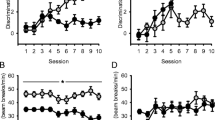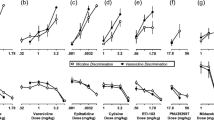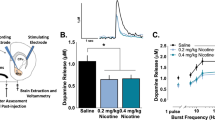Abstract
Rationale
The nicotinic receptor agonist, isoarecolone, has ‘nicotine-like’ subjective properties as detected by rats in a discrimination paradigm. However, isoarecolone lacks the intra-accumbens dopamine-releasing effects, a feature akin to most abused substances. In the five-choice serial reaction time task, isoarecolone can enhance attention and thus may be developed as a cognitive enhancer.
Objective
The present experiments assess the dependence profile of isoarecolone in rodent models of nicotine dependence.
Method and results
Tests for cross-substitution in which isoarecolone is substituted for nicotine [0.3 mg/kg/infusion (inf)] self-administration suggest isoarecolone to have nominal reinforcing properties (0.3 or 1.0 mg/kg/inf); intake of isoarecolone declined over three test sessions in which responding was no different from saline extinction, and behaviour was reinstated by re-presenting nicotine. In a model of nicotine-seeking behaviour, rats having been extinguished by removal of nicotine (0.03 mg/kg/inf) and associated cues, the presentation of priming doses of nicotine (0.1–0.4 mg/kg s.c.) with the cues robustly reinstated responding of nicotine-seeking behaviour. Tests with priming doses of isoarecolone (1–20 mg/kg s.c.) shown previously to generalise to nicotine in discrimination tests produced significant levels of reinstatement but the responses were significantly less compared to nicotine-induced reinstatement.
Conclusion
Overall, these results suggest that isoarecolone with its unique profile of behavioural activity should be further examined for treating chronic diseases that are characterised by attentional dysfunction.


Similar content being viewed by others
Explore related subjects
Discover the latest articles and news from researchers in related subjects, suggested using machine learning.References
Andreoli M, Tessari M, Pilla M, Valerio E, Hagan JJ, Heidbreder CA (2003) Selective antagonism at dopamine D3 receptors prevents nicotine-triggered relapse to nicotine-seeking behavior. Neuropsychopharmacology 28:1272–1280
Buccafusco JJ, Jackson WJ, Gattu M, Terry AV (1995) Isoarecolone-induced enhancement of delayed matching to sample performance in monkeys: role of nicotinic receptors. Neuroreport 6:1223–1227
Caggiula AR, Donny AC, White AR, Chaudhri N, Booth S, Gharib MA, Hoffman A, Perkins KA, Sved AF (2001) Cue dependency of nicotine self-administration and smoking. Pharmacol Biochem Behav 70:515–530
Chaudhri N, Caggiula AR, Donny AC, Palmatier MI, Liu X, Sved AF (2005) Complex interactions between nicotine and nonpharmacological stimuli reveal multiple roles for nicotine in reinforcement. Psychopharmacology (Berl) 184:353–366
Chiamulera C, Borgo C, Falchetto S, Valerio E, Tessari M (1996) Nicotine reinstatement of nicotine self-administration after long-term extinction. Psychopharmacology (Berl) 127:102–107
Cohen C, Perrault G, Griebel G, Soubrie P (2005) Nicotine-associated cues maintain nicotine-seeking behavior in rats several weeks after nicotine withdrawal: reversal by the cannabinoid (CB1) receptor antagonist, rimonabant (SR141716). Neuropsychopharmacology 30:145–155
Corrigall WA, Coen KM (1989) Nicotine maintains self-administration in rats on a limited-access schedule. Psychopharmacology (Berl) 99:473–478
DeVries TJ, Schoffelmeer ANM, Binnekade R, Vanderschuren LJMJ (1999) Dopaminergic mechanisms mediating the incentive to seek cocaine and heroin following long-term withdrawal of IV drug self-administration. Psychopharmacology (Berl) 143:254–260
Goldberg SR, Spealman RD, Goldberg DM (1981) Persistent behavior at high rates maintained by intravenous self-administration of nicotine. Science 214:573–575
Goldberg SR, Risner ME, Stolerman IP, Reavill C, Garcha HS (1989) Nicotine and some related compounds: effects on schedule-controlled behaviour and discriminative properties in rats. Psychopharmacology (Berl) 97:295–302
Hahn B, Sharples CG, Wonnacott S, Shoaib M, Stolerman IP (2003) Attentional effects of nicotinic agonists in rats. Neuropharmacology 44:1054–1067
Mirza NR et al (1996) The nicotinic receptor agonists (−)-nicotine and isoarecolone differ in their effects on dopamine release in the nucleus accumbens. Eur J Pharmacol 295:207–210
Olausson P, Jentsch JD, Taylor JR (2004) Nicotine enhances responding with conditioned reinforcement. Psychopharmacology (Berl) 171:173–178
Reavill C, Spivak CE, Stolerman IP, Waters JA (1987) Isoarecolone can inhibit nicotine binding and produce nicotine-like discriminative stimulus effects in rats. Neuropharmacology 26:789–792
Risner ME, Goldberg SR (1983) A comparison of nicotine and cocaine self-administration in the dog: fixed ratio and progressive ratio schedules of intravenous drug infusion. J Pharmac Exp Ther 224:319–326
Shaham Y, Adamson LK, Grocki S, Corrigall WA (1997) Reinstatement and spontaneous recovery of nicotine seeking in rats. Psychopharmacology (Berl) 130:396–403
Shoaib M, Schindler CW, Goldberg SR (1997) Nicotine self-administration in rats: strain and nicotine pre-exposure effects on acquisition. Psychopharmacology (Berl) 129:35–43
Stolerman IP (1990) Behavioural pharmacology of nicotine: implications for multiple brain nicotinic receptors. In: Bock G, Marsh J (eds) CIBA Foundation Symposium 152: the biology of nicotine dependence. Wiley, Chichester, pp 3–16
Stolerman IP, Jarvis MJ (1995) The scientific case that nicotine is addictive. Psychopharmacology (Berl) 117:2–10
Stolerman IP, Naylor C, Elmer GI, Goldberg SR (1999) Discrimination and self-administration of nicotine by inbred strains of mice. Psychopharmacology (Berl) 141:297–306
Whiteaker P, Garcha HS, Wonnacott S, Stolerman IP (1995) Locomotor activation and dopamine release produced by nicotine and isoarecolone in rats. Br J Pharmacol 116:2097–2105
Acknowledgements
We wish to thank the Medical Research Council and the University of Newcastle for funding this research. Also, we thank Dr. Nimish Sidhpura for the assistance in training some of the rats and Professor Ian Stolerman for his encouragement and advice in facilitating this research.
Author information
Authors and Affiliations
Corresponding author
Rights and permissions
About this article
Cite this article
Shoaib, M. Effects of isoarecolone, a nicotinic receptor agonist in rodent models of nicotine dependence. Psychopharmacology 188, 252–257 (2006). https://doi.org/10.1007/s00213-006-0498-9
Received:
Accepted:
Published:
Issue Date:
DOI: https://doi.org/10.1007/s00213-006-0498-9




